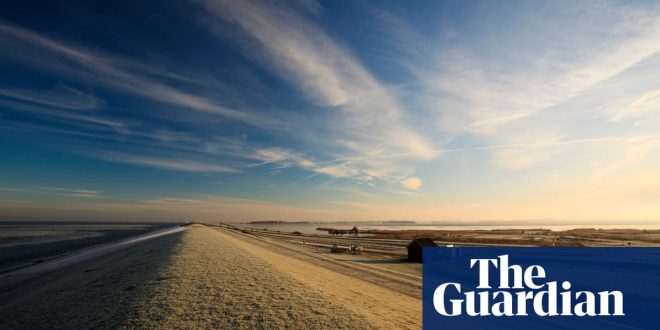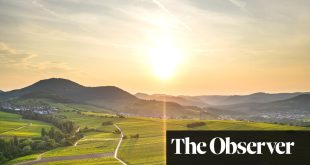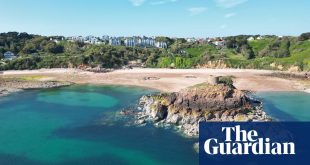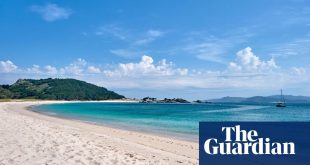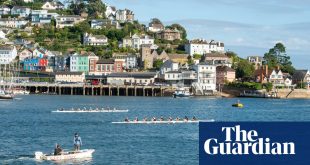At 5am, the toll of the church bell reverberates through the darkness, jolting me awake – again. The unwavering sentinel in the rural Dutch village of Eastrum has rung every half hour throughout the night. Lying on a camp bed in the nave of the 16th-century Saint Nicholas church, I begin to wonder what I’ve agreed to. But then, gazing upwards, I notice a glimmer – soft tendrils of early morning light sneak through the windows, illuminating thin gold lines painted along the edges of the church roof beams. In the stripped-back simplicity of the building’s Protestant design, the subtle glimmers feel like a heavenly wonder.
I’m in Eastrum to walk a segment of Het Ziltepad, or the Salt Path, a recently opened long-distance hiking trail that traverses the salt marshes of the sparsely populated northern Dutch provinces of Friesland and Groningen. Tracing the Wadden Sea coastline, the route invites hikers to explore local churches as a way to discover the region’s cultural heritage. If that sounds a little pious, fear not: ecclesiastical enthusiasm isn’t required. Rather, the project aims to breathe new life into the old buildings and encourage visitors to get chatting with local communities.
In a project spearheaded by nonprofit organisations Alde Fryske Tsjerken and Groninger Kerken, churches across both provinces are being repurposed as artists’ studios, community cafes, concert venues and visitor accommodation. At present, nine churches have signed up, but the goal is to connect 22 churches by 2027, from Den Helder in North Holland to Termunten in Groningen.
My journey had begun the day before, when I took an unhurried, four-hour train and bus trip from Amsterdam to the provincial city of Dokkum. From there, I followed a canal, meandering eastwards for an hour on foot. Local resident Petra Kroes had popped out of her home opposite Saint Nicholas church to show me my evening lodgings. Up to two travellers can sleep in the nave – bringing their own bedding, but with access to a toilet and washbasin as well as being served a breakfast tray.
When the church bell rings at 8.30am next day, I am still getting over my unsettled night, but I have a visitor. As part of a project inviting artists to use these churches as studios, Elisabeth Donkers has left large paper sketches scattered across the floorboards. On them, she has traced shadows cast by the arching windows. Like me, she seems captivated by the sunlight illuminating unseen details in the church.
“It’s a place of wonder,” says Lisette Durkenkamp. “It’s a place of contemplation.” The Eastrum local has come to chat about Donkers’s artwork. She is keen to stress that the church is open to everyone, but not everything. Visitors should be respectful of its peaceful character. It is an attitude I encounter regularly along the route: residents want visitors to experience life as they do, joining their community as a temporary member.
Over three days, I will cover 32 miles (52km). The first 15-mile stretch, to Lauwersoog, takes me through agricultural land and reintroduced salt marsh, with visits to churches at Ie and Eanjum, before clambering up and along the eight-mile dyke that separates the Wadden Sea from the Lauwersmeer lake. The land is so flat I can see the spires of churches I have yet to visit. Sailors once used the church spires, each architecturally unique, as navigation aides.
There is a temptation to call the horizontal planes of the landscape boring, but as I adjust to the unbroken roll of fields, smaller details emerge – a pastel fringe of wildflowers; the striped blue damselflies darting across my path; and the black-tipped ears of a hare tickling frothy cow parsley heads. Cranes, lethargic in the heat, glide down to cool their feet in the channels. Cyclists shout “Hoi” in greeting as they pass. Hikers are a novelty in the area – visitors are more likely to explore on two wheels.
“Walking through nature impacts your brain,” says Anneke Augusteijn, a psychology lecturer and owner of the Wandelschuur, my accommodation in the harbour town of Lauwersoog. Augusteijn runs walking retreats and rents out the double-height, glass-fronted hut in her garden for overnight stays.
I dine in the evening sunshine with Augusteijn, her son and their cat Nelson, discussing the Salt Path and its goal of fostering community tourism – of getting people to not just observe the landscape, but to connect with the people who live here. The next morning, after delivering a breakfast tray large enough for a family of four, Augusteijn suggests a picturesque route through the woods behind her house to get to the Strandweg, a country road that skirts the edge of the Lauwersmeer.
Formed in 1969 when the current sea dyke was built to protect Friesland from the Wadden Sea, Lauwersmeer is now a nature reserve and, with the lowest light pollution in the Netherlands, an internationally recognised dark sky park. Birdwatchers flock here to see bitterns, bluethroats and sea eagles, but are probably more likely to spot the Milky Way than the elusive birds of prey. As I walk, I see a herd of Konik ponies, an eastern European wild horse brought in to graze the salt marsh.
after newsletter promotion
In Vierhuizen, I stay at D’Olle Pastorie, a B&B run by Irene Japenga and her husband Marten, just around the corner from the Niekerk church. The next day, I pop in to the church to see another artwork-in-progress – a series of strangely shaggy pillars erected around the nave. I am joined by Ruth ter Voort from Alde Fryske Tsjerken and Patty Wageman from Groninger Kerken and from the church we trundle out along country roads for seven miles, chatting about dyke wardens and flooding, hopping over fences and ducking under “path closed” signs in what Patty calls the “stubborn Dutch way”.
By midday, Hornhuizen’s colourful red and yellow church spire comes into sight. Clambering up the stone spiral staircases and wooden ladders to the top of the spire, we get an unexpectedly vivid view – fields of shining rapeseed one way, shimmering water the other.
Wongema sits across the road. The restaurant, cafe, community space and guesthouse is surprisingly contemporary, with rooms and shared bathrooms upstairs hosting guests seeking somewhere quiet to work on personal or professional projects, as well as overnight travellers.
Wilbert van de Kamp, Wongema’s lead innkeeper, tells me the guesthouse idea came from founder Erik Wong, who envisioned an alternative community space, less commercialised than the typical village cafe. Wongema is now part-owned by Hornhuizen residents and partly by a foundation that aims to make the Dutch countryside more livable. It also hosts community events, such as the annual village “potato party”. “It’s important to have places like this in the village, a meeting place for people,” he says. “If you ask what’s the story behind this piece of furniture, or this book, or this certain area of Wongema, there are valuable stories waiting for you.”
As I prepare to leave early the next morning, I discover that Wilbert has left out homemade granola and local yoghurt for my breakfast. It’s a small touch, but it reaffirms my conclusions on what the Salt Path offers. It’s about hiking between churches, yes, but it’s also about temporarily joining a community – one that’s keen to share its small wonders.
The trip was provided by holland.com and visitwadden.nl, with train travel from London to Amsterdam provided by Eurostar. Downloadable English language route booklets will soon be available on the Visit Wadden website
 Top Naija News – Nigeria News, Nigerian News & Top Stories Top Naija News – Nigerian Newspapers, Nigerian News. topnaijanews is a daily Nigerian newspaper covering Latest News, Breaking News, Entertainment, Sports, Lifestyle and Politics.
Top Naija News – Nigeria News, Nigerian News & Top Stories Top Naija News – Nigerian Newspapers, Nigerian News. topnaijanews is a daily Nigerian newspaper covering Latest News, Breaking News, Entertainment, Sports, Lifestyle and Politics.
